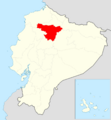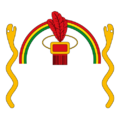Cara culture facts for kids
Quick facts for kids
Shyris
Kingdom of Quito
|
|||||||||
|---|---|---|---|---|---|---|---|---|---|
| 980–1462 | |||||||||
 |
|||||||||
| Capital | Quito | ||||||||
| Historical era | Integration | ||||||||
|
• Established
|
980 | ||||||||
|
• Disestablished
|
1462 | ||||||||
|
|||||||||
The Kingdom of Quito was a powerful ancient civilization in what is now Ecuador. It was formed by the Cara culture, who lived along the coast, and the local Quitu people. This kingdom was also known as the Shyris or Caranqui civilization. It thrived for many centuries before the arrival of the Inca Empire and later the Spanish.
History of the Kingdom
Around the 10th century CE, the Cara people traveled from the coast up the Esmeraldas River. They reached the high Andean valley where the city of Quito is now located. There, they met the local Quitu tribe. The Cara people joined with the Quitu, creating a new, strong kingdom. This combined culture, often called the Quitu-Cara or Shyris civilization, was important from about 800 CE to the 1470s.
For over four hundred years, the Kingdom of Quito was led by kings known as shyris. These kings ruled over a large part of what is now the highlands of Ecuador. The Cara people and their allies were a strong force.
However, in 1462, a huge army of 250,000 soldiers from the Inca Empire arrived. This army was led by Túpac Inca, the son of the Inca Emperor. The Cara and their allies fought bravely in big battles at Tiocajas and Tixán. Even though they fought hard, they were eventually defeated. After this, the Kingdom of Quito slowly became part of the powerful Inca Empire.
In 1534, the Quitu-Cara culture faced another major change when the Spanish arrived and took control. Many people from the Quitu-Cara culture sadly passed away because they caught new diseases brought by the Europeans. These diseases were very serious and spread quickly. Also, some Spanish conquerors married Quitu-Cara women. Over time, their children and grandchildren continued to marry people from different backgrounds. This led to a new group of people called mestizos, who gradually lost touch with their original indigenous heritage.
For a long time, some historians, like Jacinto Jijón y Caamaño and Alfredo Pareja Diezcanseco, wondered if the Kingdom of Quito truly existed. They thought it might just be an old legend from before the Spanish arrived. This was because no clear archaeological proof of the Quitu people had been found.
But in the early 2000s, something amazing was discovered in the Florida neighborhood of Quito. Archaeologists found very detailed tombs that were about 20 meters deep! These tombs date back to 800 CE, which is exactly when the Quitu-Cara culture was thriving. Each tomb held the remains of about 10 people on three different levels. Along with them were special items like textiles, carved pieces, and even food and drink. These items were likely placed there for the people to use in the afterlife.
In 2010, a museum called the Museum of Florida opened in the same neighborhood. It displays the artifacts found in these tombs. The museum also helps visitors understand the Quitu culture, showing figures of men and women dressed in traditional Quitu clothing. This discovery helped prove that the Quitu culture was indeed real and very advanced!
Legacy
Even today, the Caranqui language lives on in some ways. You can find it in place names, like the city of Carán. Also, the word Shyri, which was the title for the kings of Quito, is still used in the Ecuadorean Army as a military term.
Images for kids
See also
 In Spanish: Caranquis para niños
In Spanish: Caranquis para niños



